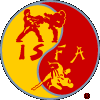Shootfighting
Shootfighting is a martial art and combat sport, with competitions governed by the International Shootfighting Association (ISFA). Shootfighting incorporates techniques from a multitude of traditional martial arts, the most principal of these being wrestling and kenpo.
 | |
| Focus | Hybrid (Combat Sport & Street Combat) |
|---|---|
| Country of origin | |
| Creator | |
| Famous practitioners | |
| Parenthood | Catch Wrestling, American Kenpo, Muay Thai, Jujutsu |
| Olympic sport | No |
Shootfighting was previously used synonymously with mixed martial arts competitions in Japan, as opposed to shoot-style professional wrestling competitions. This usage of the term is retired from common usage because it became a registered trademark of Bart Vale, who uses it to describe his hybrid fighting system derived from shoot wrestling. However, it is still sometimes used colloquially.
Examples which were once considered shootfighting styles, tournaments or organizations are Pancrase, Shoot boxing and Shooto, where many fighters still considered themselves to be shootfighters. Ken Shamrock is possibly the most recognisable shoot fighter, as this was the discipline he was credited as using in the early days of the UFC.
History
Shootfighting's use as a synonym for mixed martial arts had its genesis in the 1970s, when Karl Gotch taught a group of Japanese professional wrestlers catch wrestling techniques, called "hooking" or "shooting". In 1976, one of these pro-wrestlers, Antonio Inoki, hosted a series of mixed martial arts matches. This led to an increased interest in real and effective technique, and eventually led to the creation of shoot wrestling, with some shoot-style professional wrestling organizations hosting legitimate mixed martial arts bouts, called "shoots". In the 1990s the interest grew, and certain shoot-style organizations like Pancrase evolved into pure "shoot" organizations. The term "shootfighting" was frequently used to describe these events and styles.
The word "shootfighting" was however coined by Bart Vale, an American with a background in Concocted Combat. He was the Japanese Professional Wrestling Fujiwara Gumi (PWFG, a Japanese shoot-style professional wrestling organization) champion for close to three years. Upon moving back to America, Bart Vale used the term "shootfighting" to describe his own hybrid fighting system, which was a combination of the shoot wrestling techniques he had learned in Japan, and his experience in kenpo, jujutsu and Muay Thai. He also founded the International Shootfighting Association to promote shootfighting as a combat sport.
Rules
- (Extract from the ISFA homepages)
Currently professional shootfighting matches consists only of a heavyweight (200 lb or more) division. But there are lighter divisions for amateur competitors. Pro matches run 30 minutes non-stop, amateurs 10 minutes. Held inside a standard wrestling ring, competitors are allowed to kick, knee or elbow any part of the body except the groin, as well as headbutt. Punches are allowed to the body. Since no gloves are worn to facilitate wrestling, punches aren't allowed to the head, although open hand palms and slaps are allowed. Any type of throw or takedown is legal and competitors are allowed to hit a downed opponent. Additionally, any type of joint lock is legal as are chokes against the side of the neck. The only foul consists of punches to the face, eye-gouges, techniques against the windpipe and groin strikes.
Fights are won when a competitor is knocked down for a 10 count, knocked down 5 times or forced to submit. A fighter caught in a submission hold may grab the ropes to break the hold, but this counts as a 1/3 of a knock down. Grabbing the ropes 15 times equals a loss. Bouts that go to the full time limit are declared a draw.
See also
- Aliveness (martial arts)
- Pancrase
- Pride Fighting Championships
- Fighting Network RINGS
- Puroresu
- Shooto
- Ultimate Fighting Championship
- Vale tudo
References
- Chan, Sam. The Japanese Pro-Wrestling: Reality Based Martial Art Connection. bjj.org. URL last accessed January 7, 2006.
- Herzog, Paul. History of Shootfighting. www.mindspring.com. URL last accessed January 7, 2006.
- International Shootfighting Association. History of the ISFA. www.shootfighting.com. URL last accessed January 7, 2006.
External links
- International Shootfighting Association The homepage of the International Shootfighting Association.
- Official Shootfighting information & training in Vallejo, Fairfield, Vacaville & Davis, CA
- American Kenpo & Shootfighting
- Swedish Shootfighting Association